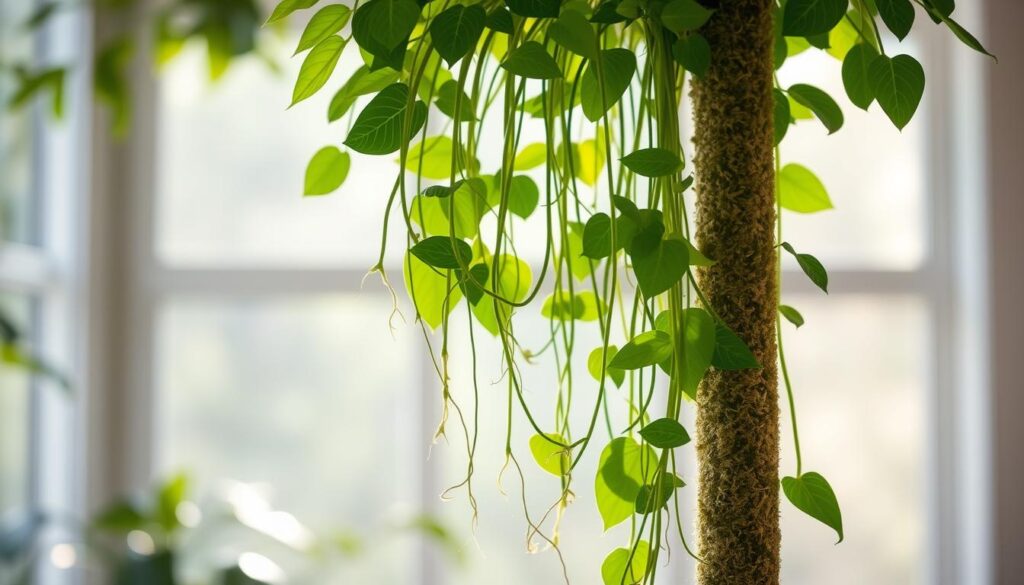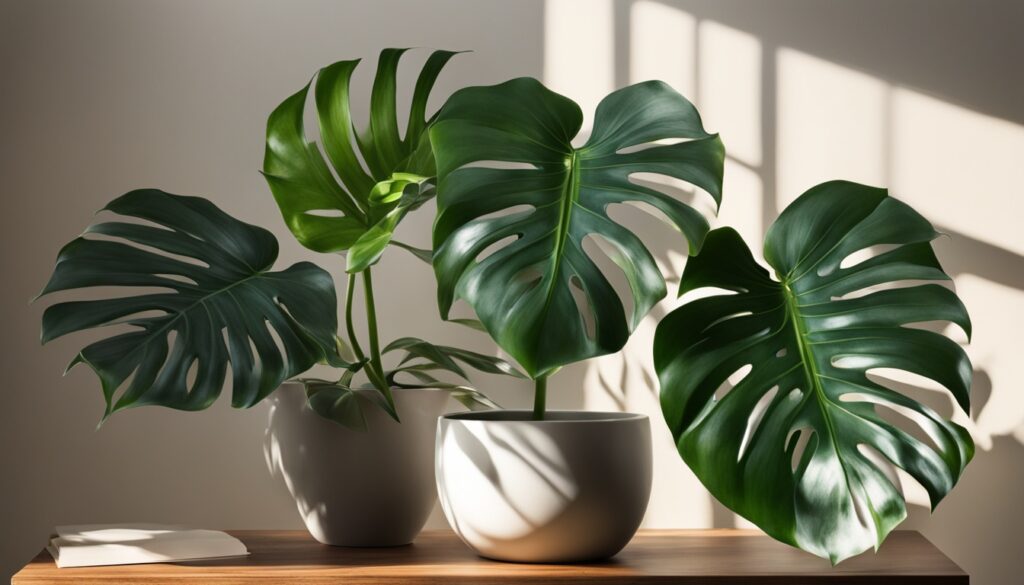Are you searching for the perfect moss pole for your pothos plant? Pothos love to climb, and the right support is key for their growth. But with many options, picking the best moss pole can be tough.
In this guide, we’ll explore moss poles for your Pothos. We’ll look at materials, sizes, and designs that boost your plant’s growth and look. Whether you’re new to plants or experienced, you’ll learn what to look for in a moss pole to support your climbing Pothos plant.
Key Takeaways
- Moss poles give climbing Pothos plants the support they need, helping them grow vertically.
- The type of moss pole you choose affects your Pothos’ health and looks.
- Think about water retention, durability, and environmental impact when picking a moss pole.
- DIY moss poles let you customize, but pre-made ones offer quality and ease.
- Installing and caring for your moss pole is vital for your Pothos’ success.
Understanding Why Pothos Need Climbing Support
Pothos plants, also known as Devil’s Ivy, are natural climbers. They thrive with the right support. These lush, trailing vines grow best when they can climb and display their foliage vertically. Providing a climbing support, such as a pothos pole totem or other climbing, allows these plants to grow in a form closer to their natural state. This promotes healthier growth and larger leaves.
Natural Growth Patterns of Pothos
In their natural habitat, pothos plants grow as epiphytes. They use aerial roots to climb trees and other structures. This vertical growth pattern allows them to access more sunlight and improve air circulation around the plant.
Benefits of Vertical Growth for Plant Health
By encouraging pothos plants to grow vertically with the help of a pothos climbing support, you can ensure they receive optimal sunlight and air flow. This leads to healthier foliage, larger leaves, and more vigorous growth.
Role of Aerial Roots in Climbing
Pothos plants are equipped with aerial roots that help them attach and climb to various surfaces. Providing a suitable structure, such as a moss pole or coco coir pole, allows these aerial roots to cling and support the plant’s upward growth.
“Moss poles are a common choice for aroids like Monstera, Philodendron, and Pothos, as they provide support for these epiphytic plants to grow upwards and are essential for vines to attach and climb.”
Different Types of Moss Poles Available
There are many moss poles to choose from for your pothos plants. You can find everything from classic coco coir to new sphagnum moss and forest moss-covered poles. Each option is designed to meet your plant’s needs.
Some poles have a PVC or wire center for extra stability. Others are bendable, letting you shape them as you like. You can pick from round or square shapes, in various sizes and heights. For growing plants, there are stackable or extendable poles to support your pothos as it grows.
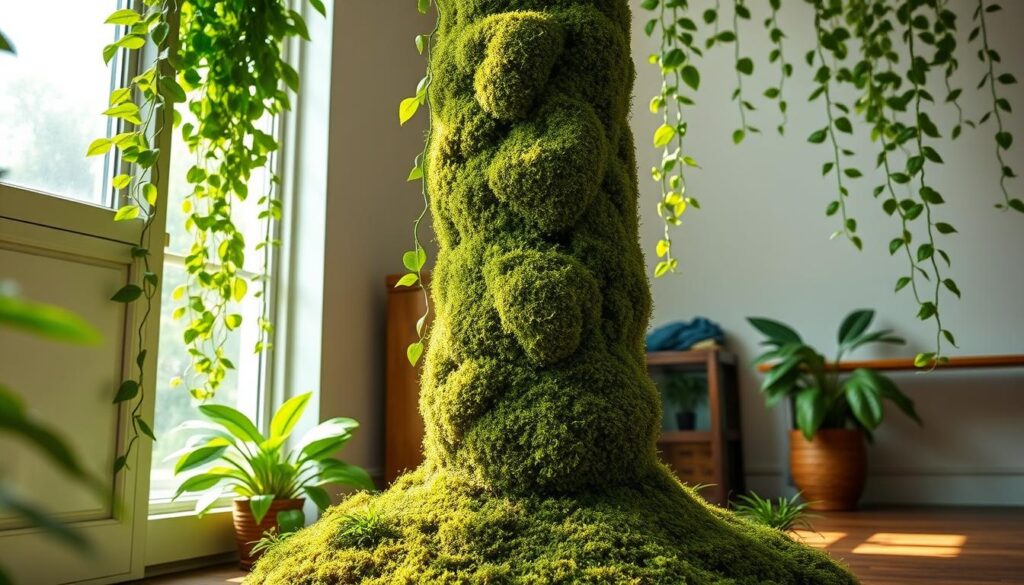
The Envelor Coco Moss Totem Pole is a favorite for its height and strength. It’s perfect for bigger pothos plants. Lanney offers a coir stackable pole system in a 4-pack, with two 12-inch and two 17-inch poles.
If you prefer something eco-friendly, try the Mosser Lee Plant Support. It has a fiber net over sphagnum moss on a solid center. This provides moisture and strength. The Number One brand has bendable plant sticks made of coco coir, mimicking a tree trunk.
No matter what you’re looking for, there’s a moss pole out there for you. You can find the ideal support for your pothos plant, helping it grow and reach new heights.
Best Moss Pole for Pothos: Top Recommendations
Finding the right moss pole is key for your pothos plant. There are many options, from high-quality to affordable. Each one is designed to meet your pothos’s needs.
Premium Quality Options
The Duspro Forest moss poles and Envelor coco moss totem poles are top picks. They have a bendable design and lush moss. This gives your pothos the support and moisture it needs.
Budget-Friendly Choices
For a cheaper option, consider basic coir-wrapped dowels. They’re simple yet effective for your climbing plant. And they won’t cost a lot.
Extendable Solutions
For growing pothos, try the Lanney stackable coir poles or Taonmeisu’s plastic plant pole. They adjust in height. This lets your plant grow without needing a new pole.
| Moss Pole Type | Price Range | Unique Features |
|---|---|---|
| Duspro Forest Moss Pole | £74.99 – £119.99 | Bendable design, lush forest moss coverage |
| Envelor Coco Moss Totem Pole | £59.95 – £99.95 | Coir moss material, excellent moisture retention |
| Coir-Wrapped Dowel | £32.99 – £49.95 | Budget-friendly, simple design |
| Lanney Stackable Coir Pole | £54.99 – £89.99 | Adjustable height, coir moss material |
| Taonmeisu Plastic Plant Pole | £44.99 – £84.99 | Extendable, plastic construction |
With these moss pole recommendations, you can find the best support for your pothos. It will help your plant grow and thrive.
Coir vs. Sphagnum Moss: Which is Better?
Choosing the right support for your pothos plant can be tough. Coir and sphagnum moss poles both have their own perks. Your choice depends on what your pothos needs and what you like best.
Coir poles are loved for being strong, affordable, and easy to use. They give your plant the support it needs for a long time. Plus, they can handle cold weather and strong winds, making them great for many places.
Sphagnum moss poles are perfect for tropical plants like pothos. They hold a lot of water, up to 20 times their weight. This is great for plants that like to climb. They also keep pests and bacteria away, making them look good and safe for your plant.
“Coir poles are the preferred choice for plant support due to their durability, affordability, and ease of use, while moss poles excel in providing moisture and support for tropical plants with aerial roots.”
But, moss poles need more water and might need to be replaced often. They can also get knocked over in windy weather. They need to stay wet to stay strong.
So, it really comes down to what you need. If you want something that lasts a long time and can handle the weather, go for a coir pole. But, if your pothos loves a moist, warm place, a sphagnum moss pole might be the best choice.

Size and Height Considerations for Moss Poles
Choosing the right size and height for your pothos plant is key. Moss poles for pothos vary in size. They are usually between 12 to 63 inches tall and 1.5 to 2.5 inches wide.
Standard Sizes Available
Common moss pole sizes for pothos include:
- 24-inch poles
- 36-inch poles
- 48-inch poles
Matching Pole Size to Plant Size
It’s important to pick a moss pole that matches your pothos plant’s size. The right pothos pole totem supports your plant as it grows. The pole should be 1 to 2 feet taller than your plant. Also, 6 to 12 inches of the pole should be buried in the soil for stability.
Choosing the right pothos plant pole size helps your plant grow well. It makes your plant look great and helps it grow bigger and greener.
How to Choose the Right Support Material
Choosing the right support for your pothos plant is key. Options like coco coir and sphagnum moss can help your plant grow. Think about moisture, looks, and durability to pick the best.
Coco coir is a great choice for pothos. It holds moisture well and is good for the planet. It also helps roots grow strong and healthy.
Sphagnum moss is another good option. It keeps moisture around roots and looks natural. It’s perfect for plants that like a bit of humidity.
- Coco coir: Excellent moisture retention, eco-friendly
- Sphagnum moss: Moisture-holding capabilities, natural aesthetic
- Forest moss: Unique texture and appearance, may require more maintenance
- Combinations: Blending materials for optimal moisture and support
Some supports mix materials for better moisture and support. These can be moss-covered or a mix of coir and moss.
| Support Material | Moisture Retention | Aesthetics | Durability |
|---|---|---|---|
| Coco Coir | High | Natural, earthy | Moderate |
| Sphagnum Moss | High | Rustic, organic | Moderate |
| Forest Moss | Moderate | Unique, lush | Lower |
| Coir and Moss Blend | High | Natural, varied | High |
Think about what you want for your plant and space when picking support. The right support lets your pothos climb high and look great.
Bendable vs. Rigid Moss Poles: Pros and Cons
Moss poles are a favorite for supporting plants like pothos. Gardeners often choose between bendable and rigid poles. Each has its own benefits, depending on your pothos pole for vining or pothos plant pole needs.
Benefits of Flexible Support
Bendable moss poles, like those from RSSCIIUL, are very versatile. They can be shaped to fit your pothos pole for vining needs. This is great for big plants or unique spaces.
They help you create stunning displays and use vertical space well.
Advantages of Rigid Structure
Rigid moss poles, such as those from Syndicate H&G, offer solid support. They are often cheaper and reliable for your pothos plant pole. Their firm structure keeps your plant in shape, perfect for small spaces or plants needing structure.
Choosing between bendable and rigid poles depends on your plant, space, and style. Weighing the pros and cons helps you pick the best for your pothos pole for vining or pothos plant pole.
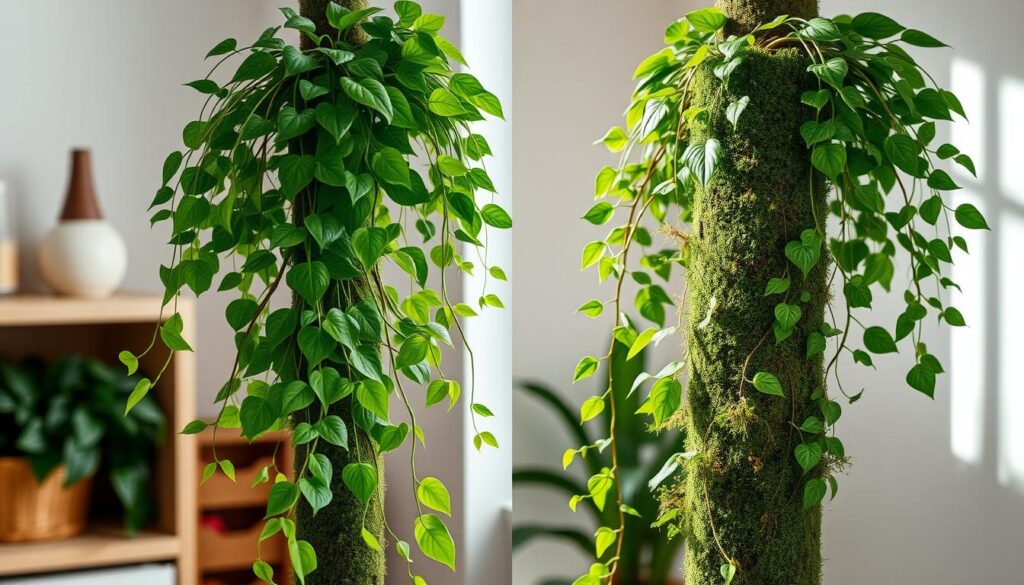
Installation and Setup Guidelines
Setting up a moss totem for your pothos climbing support is easy. Just put the moss pole deep into your pothos plant’s soil. Make sure it’s stable and secure.
For extra stability, use the anchors or pins provided. This keeps the moss totem upright. It also stops it from moving as your pothos grows.
- Use plant tape, twist ties, or soft twine to tie the pothos vines to the moss pole.
- As the plant grows, guide it to wrap around the moss totem.
- Check and adjust the ties often to fit the plant’s growth.
By following these steps, you’ll give your pothos the support it needs. It will thrive and show off its beautiful foliage.
“Moss poles offer a defined path for plants to grow upward, making them ideal for trailing plants like pothos compared to trellises.”
Maintaining Moisture and Stability
Moss poles need watering about once a week. This depends on your home’s humidity and the pole’s height. It keeps the support moist and stable.
With proper care, your moss totem will support your pothos well. It will climb high and display its lush foliage beautifully.
Maintaining Your Moss Pole
It’s important to keep your pothos moss pole or totem in good shape. This helps your climbing plant grow and stay healthy. Focus on keeping it moist and clean.
Moisture Requirements
Moss poles need to stay moist to grow well. This helps your pothos plant’s aerial roots grow. Mist the pole often with a spray bottle or a small watering can. Check the pole’s moisture and add more as needed.
Cleaning and Care Tips
- Regularly clean the moss pole to remove dust or debris. This stops mold or mildew from growing, which is bad for your plant.
- Use a soft cloth or brush to gently clean the pole. Be careful not to harm the moss.
- If the moss gets old or too dense, it might be time to replace or extend the pole. This lets your pothos grow more.
Keeping your pothos moss pole or totem moist and clean helps your plant thrive. It will keep climbing and reaching new heights.
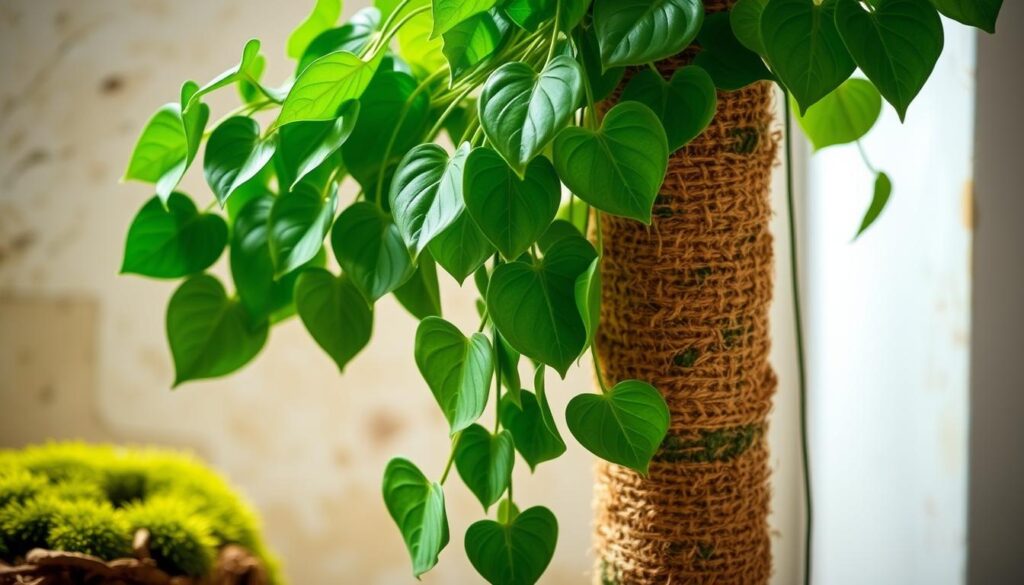
Signs Your Pothos Needs a Bigger Pole
As your pothos plant grows, it’s key to watch its climbing needs. You’ll know it needs a bigger pole or a better climbing system when you see these signs:
- Vines growing beyond the top of the current pole, indicating the plant has outgrown its support.
- Aerial roots searching for new attachment points, suggesting the need for a taller or wider pole.
- Overcrowding of leaves and stems on the pole, signaling it’s time to upgrade to a more spacious climbing system.
When your pothos plant pole feels cramped or restrictive, it’s time to upgrade. You can choose a taller or wider pole. Or, go for a pothos pole for vining that can grow with your plant, like a stackable moss pole system.
Right climbing support makes your pothos look great and grow well. By watching for these signs, you can help your pothos reach its best.
“Proper support is essential for the long-term health and vibrant growth of your pothos plant.”
Stackable Moss Pole Systems
Stackable moss pole systems, like those from Lanney, are great for pothos climbing support. They come in different lengths that can stack up. This lets you grow your pothos without harming its roots.
These systems are loved by many gardeners. You can start with a short pole and add more as your pothos grows. This way, your plant gets the support it needs and looks great too.
Setting up and taking care of these poles is easy. They fit together well, so you don’t need to worry about complicated setups. You can also clean or change parts as needed. This keeps your pothos climbing support strong and healthy.
| Product | Rating | Reviews |
|---|---|---|
| DUSPRO Stackable Moss Pole For Plants Monstera | 4.5 out of 5 stars | 1,558 ratings |
| K-Brands Moss Pole (2 Pack, 116 cm) | 4.6 out of 5 stars | 603 ratings |
| OFFCUP Moss Pole, 4pcs Plastic Moss Pole | 4.2 out of 5 stars | 124 ratings |
Stackable moss pole systems are great for both new and experienced plant lovers. They offer a flexible way to support your pothos. This helps your pothos grow and look amazing.
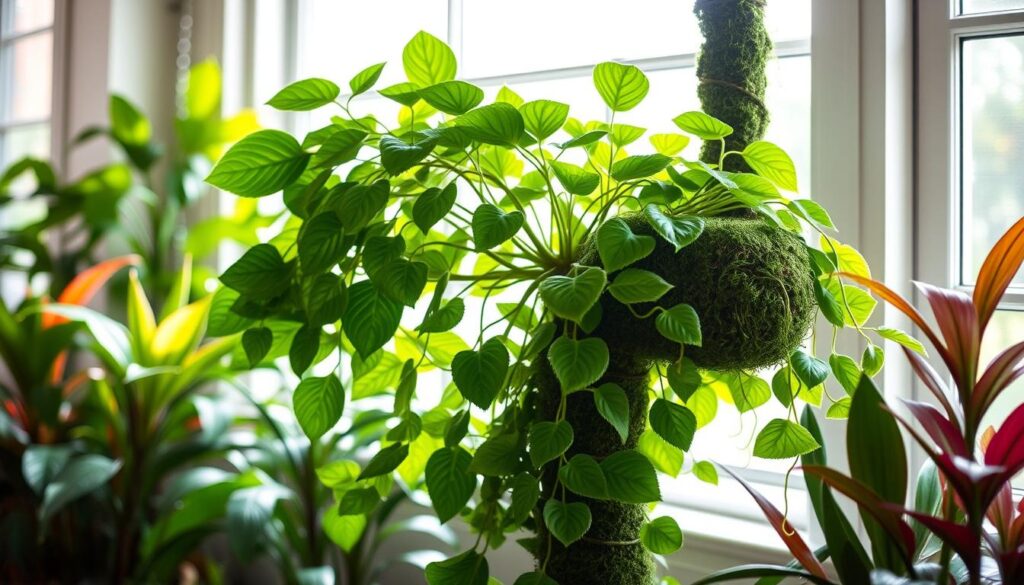
Choosing the right moss pole system is important. It should be durable and adjustable for your pothos. With the right setup, your pothos can thrive and make your home beautiful.
Common Issues with Moss Poles
Moss poles are great for climbing plants like pothos. But, they can have some common problems. Knowing how to fix these issues can help your pothos grow well on the best moss pole for pothos.
Stability Problems
One big worry with moss poles is keeping them stable. Large pothos plants can make the pole tip over. To avoid this, make sure to anchor the pole well and use a sturdy base.
Moisture Retention Issues
Keeping the moss pole moist is key for pothos aerial roots. Some poles dry out fast, especially in warm places. To keep the pole moist, mist it often or choose poles made from coir.
“Adapting to a plant’s needs through trial and error may be necessary as not all plants respond the same to moss poles.”
Remember, not every pothos reacts the same to moss poles. Try different things to see what works best for your plant.
DIY Moss Pole Alternatives
Plant lovers looking for affordable and unique options can try DIY moss pole alternatives. These homemade supports offer a way to give your pothos and climbing plants the vertical space they need. Plus, you can make them fit your style and the needs of your plants.
One DIY method is to make a moss pole with bamboo stakes or dowels covered in sphagnum moss or coco coir. This mix of bamboo strength and natural fiber moisture retention makes a strong and useful support. Coco coir moss poles are very popular, especially for Monstera Deliciosa, because they’re affordable.
Another idea is to use natural branches or twigs as trellises for your pothos. These natural supports not only help your plants climb but also add a charming, rustic touch. Manufactured sphagnum moss poles are great for keeping plants moist and healthy.
- Homemade trellises made from chicken wire, PVC pipes, or old picture frames are cheap and customizable.
- Bamboo moss poles are strong and good for heavy climbers like Monsteras and Philodendrons.
- Sheet plastic moss poles are also cost-effective and can be customized, but they need support to grow.
These DIY options save money and let you get creative. They help your pothos plant grow well and look great indoors or outdoors. DIY moss poles let you make your own supports with PVC pipes, chicken wire, and sphagnum moss. This makes it easy to try new things.
| Moss Pole Type | Durability | Cost | Customization |
|---|---|---|---|
| Coco Coir Moss Pole | 2-3 years | Affordable | Limited |
| Sphagnum Moss Pole | 2-3 years | Moderate | Limited |
| Bamboo Moss Pole | 3-5 years | Moderate | Moderate |
| DIY Moss Pole | Varies | Budget-friendly | High |
Exploring DIY moss pole alternatives lets plant lovers find affordable and personalized ways to support their plants. It’s a chance to be creative and help your plants grow and thrive.
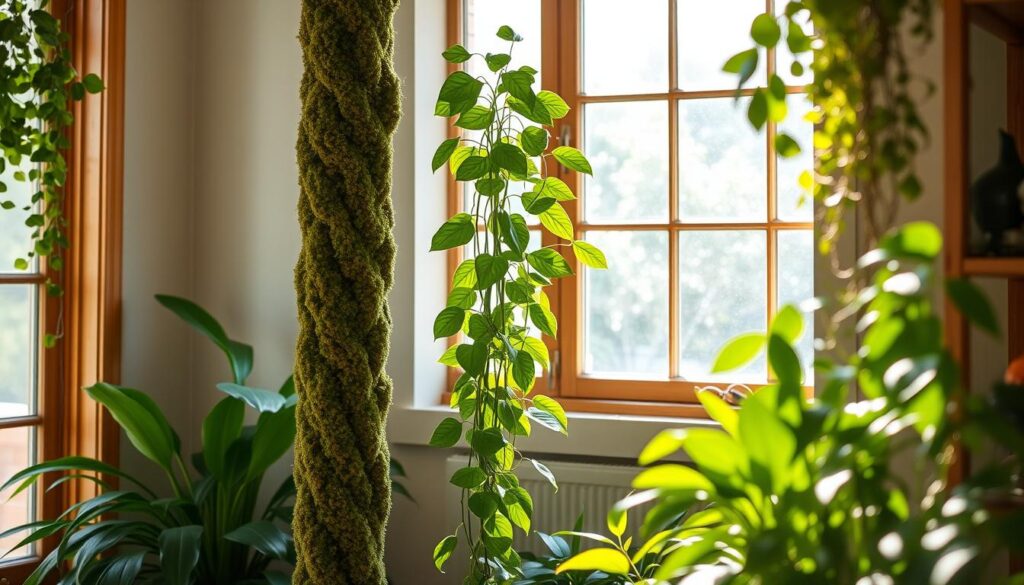
Cost Comparison of Different Options
Choosing the right moss pole for your pothos plant involves looking at the cost. Prices vary based on size, material, and features. Knowing these differences helps you pick a pole that fits your budget and meets your plant’s needs.
The cheapest option is usually the basic coir-wrapped dowels. These poles start at $5 to $15. They’re simple but might not last as long as more expensive options.
For a better investment, consider bendable moss poles and extendable moss poles in the $20 to $50 range. These poles let you change their shape and height as your pothos grows. They’re a good choice for the long run.
| Moss Pole Type | Average Price Range | Key Features |
|---|---|---|
| Coir-Wrapped Dowels | $5 – $15 | Simple, affordable support |
| Bendable Moss Poles | $20 – $50 | Customizable shape and height |
| Extendable Moss Poles | $20 – $50 | Adjustable to accommodate plant growth |
When picking a moss pole for your pothos pole for vining, think about the long-term benefits. A quality, versatile pole might save you money by lasting longer. Look around to find the best best moss pole for pothos that matches your budget and needs.
Conclusion
Choosing the right moss pole for your pothos is key. It gives them the support they need and lets them climb naturally. You can pick from premium bendable poles, budget coir options, or DIY solutions. The most important thing is to find one that fits your pothos’s needs and your garden’s look.
When picking a moss pole, think about size, material, how flexible it is, and the cost. A good moss pole will help your pothos grow well and look great. It creates a humid spot that your pothos loves, making them grow up beautifully.
Moss poles aren’t just for pothos. They work well with Monstera, Philodendron, and Raphidophora tetrasperma too. They help your plants climb, making your indoor space lively and full of life. This way, you can enjoy a beautiful, thriving indoor garden.
